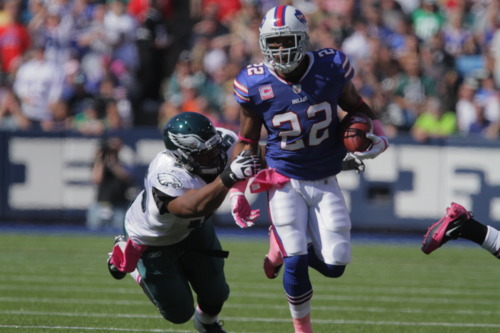But as I was watching the Eagles-Giants game on Sunday, I was drawn to this question. The Eagles defense has problems across the board. The new corners can at least tackle better than their predecessors, but remain inconsistent in coverage. Even at their best, neither Cary Williams nor Bradley Fletcher scares an opposing quarterback. Meanwhile, the front seven is a transitioning mess. Sopoaga barely shows up, and two-gapping hides last year's stud Fletcher Cox. Connor Barwin has been solid, but Trent Cole is hit-or-miss at OLB. Mychal Kendricks makes terrifically athletic plays, then falls down in coverage. The responsibilities in the run game are unclear. The pass rush is nonexistent, which has led to the bizarre move of making Brandon Boykin a rush linebacker.
This is all granted. It's a bad defense with a lot of personnel and scheme questions. But unlike the offensive side of the ball, where a great quarterback or running back can carry a team at times, defense often seems to be about your weakest link. A smart, patient, accurate quarterback can find your weakness and exploit it. Such was evident against the Peytons, but I'm not sure how much there is to learn from a drubbing at their formidable hands.
The Elis posed a much less dangerous threat. The Giants offense only scored 7 points in the two previous games. Yet they put up three times that on Sunday. Why? Again, there are many problems with this defense. The front seven, most notably, failed to register a sack until the end of the game, against a banged-up Giants offensive line.
But looking at the tape and the numbers, I'd single out safety as by far the biggest problem. The Giants only had three scoring drives. The officials gifted them the last one on a bogus pass interference call on Brandon Boykin. On the other two, 80% of the Giants' total yards were gained on four plays of 20 yards or more. What all four plays had in common was the Eagles' safeties.
On the Giants' first drive, Hakeem Nicks caught a 49-yard bomb from Manning, the second attempt in a row to split Nate Allen and Bradley Fletcher. Two plays later, David Wilson plunged into the end zone.
The second scoring drive, in the third quarter, started with a 26-yard pass to Brandon Myers where the tight end found a huge hole down the middle between Allen and Earl Wolff. Two plays later, Manning found a wide open Reuben Randle for 20 yards. Looked like Wolff should have been covering that zone, but ran with Myers over the middle instead.
Finally, the drive culminated in a disgustingly easy 24-yard TD pass to Randle. We don't have All-22 yet, but let's break that one down anyway. The Giants have three WRs, one TE, and one RB. The Eagles are going to play what looks like (again, pre-coaches tape) a variant of Cover One Robber. The defense is in man-to-man across the formation. At the snap, Allen (in blue) is going to drop into a centerfield role while Wolff rolls into the short middle. The rookie's job in Robber coverage is to help in run support if necessary, then read the QB's eyes and jump into those short and intermediate crossing routes.
Below, you can see what happens after the snap. Kendricks has blitzed, and DeMeco Ryans is looping around him (and possibly reading the running back). That leaves Wolff as the sole middle-of-the-field defender. At the top, Randle is going to run a slant against Fletcher.
Below, Manning has stared down Randle, but as he throws, Wolff hasn't moved much. Meanwhile, Fletcher is dropping further back guarding against getting beat deep in man. This leaves a big hole in the zone where Wolff ideally should be:
As Randle catches the ball below, the defense has failed. He's about to pick up a first down because neither Fletcher, who dropped way back, nor Wolff were there to stop an easy slant. Still, with three guys converging -- including Allen from his deep role -- at least it should stop there...
Except wait, no, that's not what happens. You can see below that Wolff was not only late, but he took a terrible angle at Randle and didn't even lay a finger on him. Ditto for Allen, who does this all the time. Randle scampers in for the easy touchdown.
It's worth pointing out that Boykin (bottom) is basically standing still in the last screenshot. If you re-watch the play you'll see that he slows down, seeing what we did, that the Eagles have three defenders set to shut Randle down. As the receiver breaks free instead, Boykin has an "Oh $&!#" moment, where he briefly tries to recover and help out. But it's too late.
So overall, what do we learn? The Eagles defense has a lot of problems, but the biggest mistakes all came from the two safeties. I'd venture that without those, the Eagles might have held the Giants to only 7 or 10 points. That's why I wonder how much better this defense would be with just one competent safety. Getting Patrick Chung healthy again will certainly help some, but I'm already looking ahead to the 2014 free agent class. Jairus Byrd? Donte (W)Hitner? An above-average player at that position would do wonders for this team.


